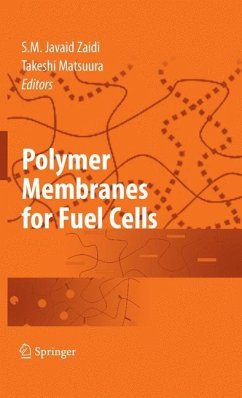This book offers one of the most comprehensive reviews written by a large number of experts in the field of development of polymeric membranes for polymer electrolyte membrane fuel cell (PEMFC). Readers of the book will feel tremendous enthusiasm that is caused when social necessity for alternative energy sources is combined with intellectual curiosity of researchers. The topics hence cover a very wide range, from the membranes developed in a large scale by industries to those developed in the academic laboratories. This book is unique since it is the first book exclusively dedicated for fuel cell membranes. The book is written for engineers, scientists, professors, graduate students as well as general readers in universities, research institutions and industries who are engaged in R & D.
From the late-1960's, perfluorosulfonic acid (PFSAs) ionomers have dominated the PEM fuel cell industry as the membrane material of choice. The "gold standard' amongst the many variations that exist today has been, and to a great extent still is, DuPont's Nafion® family of materials. However, there is significant concern in the industry that these materials will not meet the cost, performance, and durability requirementsnecessary to drive commercialization in key market segments - es- cially automotive. Indeed, Honda has already put fuel cell vehicles in the hands of real end users that have home-grown fuel cell stack technology incorporating hydrocarbon-based ionomers. "Polymer Membranes in Fuel Cells" takes an in-depth look at the new chem- tries and membrane technologies that have been developed over the years to address the concerns associated with the materials currently in use. Unlike the PFSAs, which were originally developed for the chlor-alkali industry, the more recent hydrocarbon and composite materials have been developed to meet the specific requirements of PEM Fuel Cells. Having said this, most of the work has been based on derivatives of known polymers, such as poly(ether-ether ketones), to ensure that the critical requirement of low cost is met. More aggressive operational requi- ments have also spurred the development on new materials; for example, the need for operation at higher temperature under low relative humidity has spawned the creation of a plethora of new polymers with potential application in PEM Fuel Cells.
From the late-1960's, perfluorosulfonic acid (PFSAs) ionomers have dominated the PEM fuel cell industry as the membrane material of choice. The "gold standard' amongst the many variations that exist today has been, and to a great extent still is, DuPont's Nafion® family of materials. However, there is significant concern in the industry that these materials will not meet the cost, performance, and durability requirementsnecessary to drive commercialization in key market segments - es- cially automotive. Indeed, Honda has already put fuel cell vehicles in the hands of real end users that have home-grown fuel cell stack technology incorporating hydrocarbon-based ionomers. "Polymer Membranes in Fuel Cells" takes an in-depth look at the new chem- tries and membrane technologies that have been developed over the years to address the concerns associated with the materials currently in use. Unlike the PFSAs, which were originally developed for the chlor-alkali industry, the more recent hydrocarbon and composite materials have been developed to meet the specific requirements of PEM Fuel Cells. Having said this, most of the work has been based on derivatives of known polymers, such as poly(ether-ether ketones), to ensure that the critical requirement of low cost is met. More aggressive operational requi- ments have also spurred the development on new materials; for example, the need for operation at higher temperature under low relative humidity has spawned the creation of a plethora of new polymers with potential application in PEM Fuel Cells.








